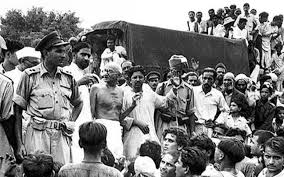Here’s an expanded account of the Champaran Satyagraha (1917) and its significance:
- The Champaran district in Bihar was a major center for indigo cultivation during British rule. Indigo, a valuable dye, was in high demand in Europe, and British planters forced Indian farmers to cultivate indigo under oppressive conditions.
- One of the main exploitative systems was the Tinkathia system, which required farmers to dedicate three out of every twenty parts of their land to grow indigo. This system was highly exploitative because:
- Economic Losses: Farmers had to grow indigo instead of more profitable or essential food crops, leading to economic distress and food shortages.
- Low Compensation: Farmers were paid meager amounts for the indigo, which barely covered their costs, let alone allowed for a profit.
- Soil Degradation: The repeated cultivation of indigo degraded the soil, making it less fertile for other crops.
- Mahatma Gandhi was approached by local farmers and activists, including Raj Kumar Shukla, who requested his intervention. Gandhi agreed and arrived in Champaran in April 1917.
- Fact-Finding Mission: Gandhi began by touring villages, meeting farmers, and documenting their grievances. He emphasized understanding the plight of the people before taking action.
- Legal Battle and Arrest: Gandhi was served with an order to leave the district by British authorities. However, he defied the order and continued his investigation, which led to his arrest. His trial garnered widespread attention, and the government eventually dropped the case against him.
- Formation of Inquiry Committee: Due to the growing pressure and Gandhi’s non-violent protest, the British government agreed to form an inquiry committee to look into the grievances. Gandhi was made a member of this committee.
- Abolition of Tinkathia System: The inquiry confirmed the exploitative practices, leading to the abolition of the Tinkathia system.
- Compensation to Farmers: British planters were compelled to refund a portion of the money they had taken from the farmers.
- Reduction in Indigo Cultivation: Farmers were given more freedom to decide the crops they wanted to grow, leading to a reduction in indigo cultivation.
- First Major Victory of Satyagraha: Champaran was Gandhi’s first successful application of satyagraha in India, demonstrating the effectiveness of non-violent resistance.
- Mass Mobilization: It marked the beginning of mass mobilization in India’s freedom struggle, involving ordinary peasants and uniting them against colonial policies.
- Gandhi’s Emergence as a Leader: The success of Champaran solidified Gandhi’s role as a key leader in the Indian independence movement. It established his strategy of non-violent protest as a powerful tool against colonial rule.
- Inspiration for Future Movements: The Champaran Satyagraha inspired subsequent movements like the Kheda Satyagraha (1918) and the Non-Cooperation Movement (1920-1922), furthering India’s fight for independence.
- The Champaran Satyagraha remains a landmark in Indian history as it highlighted the power of peaceful resistance and grassroots activism. It not only alleviated the immediate suffering of the farmers but also laid the groundwork for a broader struggle against British imperialism. Gandhi’s leadership in Champaran became a template for future civil disobedience movements, making it a crucial chapter in the story of India’s path to independence.







